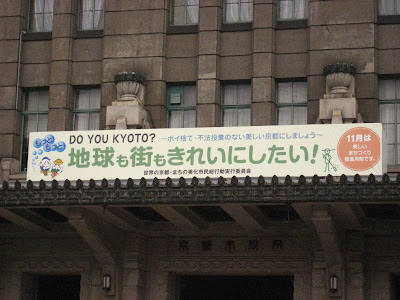We live in Nagano prefecture. You know, where the winter Olympics were in '98. We have the Japanese Alps and we have snow. It gets cold. How cold? Last year our olive oil froze. My face wash froze. We hear that our predecessors used to unplug the fridge in the winter. Cold.
Why? We ask ourselves that all the time. We both grew up in the frozen tundra of the Midwest. We can handle cold. Also, Japan is so technologically advanced. You'd think they'd have robots following you around blowing hot air at you or something. Not the case.
Here's the situation: we have single-paned glass windows. Then we have shoji screens covering those. Shoji screens are paper. I don't think the house has any insulation to speak of. So far we've been lucky and it's been in the 40s and 50s but it looks like the cold snap is coming this week.
So, here are 8 things we're doing to stay warm, in no particular order. We are still learning some tricks and hope to pick up some more ideas this winter.
1) Kerosene heaters. These are illegal in most US states. They're pretty messy (have to funnel from a large container into the heater) and can cause fires. Also, there is a risk of asphyxiation as they consume oxygen and, if used in a small unventilated room, can use up all the oxygen and/or cause carbon monoxide poisoning (killing you without warning). This is the main heating system used in Japan. My school has one in every classroom. I have one blowing at me right now. They are also stinky.
2) Electric heater. We are borrowing an electric heater from a friend. It gives off almost no heat so we mostly dry clothes on it. It turns out clothes don't dry when it's too cold (and, like most of the world, almost no one has dryers here). So, we may have to start going to the laundromat if we don't want to rotate them constantly on the electric heater.
3) Kotatsu. This is a low table with an electric heater under it and blanket over it. You sit under it...all winter long. Families eat under it. Some people sleep under it. We just got a couch and now we're back on the floor camping under the ol' kotatsu.
4) Hot water bottle. Simple enough -pour boiling water in a plastic bottle, cover it with a fuzzy cozy and sleep with it or hug it while sitting under the kotatsu.
5) Onsen. Pay a couple of bucks to go to your local hot spring for a bath. Get as warm as you can handle and then hurry home to bed.
6) Heat packs. All my students have these little hand warmers in their pockets. They also have adhesive ones that you can stick to your shirt. My teacher says she wears one on her back every day in winter. I guess they're like the hand warmers hunters use except they're necessary for daily indoor survival here.
7) Layering. It's only early December and I'm already wearing socks, leg warmers, leggings, pants, tank top, long sleeve shirt, sweater, jacket and scarf to school. What else can I add? Another pair of socks? I went to the chain store Uniqlo and was amazed at the array of under clothes - long sleeve shirts and leggings for men and women to wear under their clothes. Also, they have these fuzzy bloomers for school girls to wear under their skirts. I've also seen a stomach warmer -like a leg warmer that you wear around your middle section. You may be too thin if you're willing to add a layer there.
8) Creative thinking. Put your clothes under your kotatsu while you shower or eat breakfast so they're warm when you put them on. Learn how to set your kerosene heater so it turns on 20 minutes before your alarm goes off. We want to figure out if we can cover our windows with plastic (like we do in the US). We've already hung curtains and blankets over our windows to keep some of the heat in and cold out. We've already put foam strips on our fusuma door frames to fill in the gaps.
9) Heated toilet seat. How could I almost have forgotten one of the best Japanese inventions ever? We are so grateful for our heated toilet seat since our bathroom area has no heat at all otherwise. Why don't we have these in the US?
Please tell us your ideas for staying warm!! We're wide open for suggestions...




















































